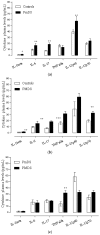Peripheral Inflammatory Markers Contributing to Comorbidities in Autism
- PMID: 27983615
- PMCID: PMC5197942
- DOI: 10.3390/bs6040029
Peripheral Inflammatory Markers Contributing to Comorbidities in Autism
Abstract
This study evaluates the contribution of peripheral biomarkers to comorbidities and clinical findings in autism. Seventeen autistic children and age-matched typically developing (AMTD), between three to nine years old were evaluated. The diagnostic followed the Diagnostic and Statistical Manual of Mental Disorders 4th Edition (DMS-IV) and the Childhood Autism Rating Scale (CARS) was applied to classify the severity. Cytokine profile was evaluated in plasma using a sandwich type ELISA. Paraclinical events included electroencephalography (EEG) record. Statistical analysis was done to explore significant differences in cytokine profile between autism and AMTD groups and respect clinical and paraclinical parameters. Significant differences were found to IL-1β, IL-6, IL-17, IL-12p40, and IL-12p70 cytokines in individuals with autism compared with AMTD (p < 0.05). All autistic patients showed interictalepileptiform activity at EEG, however, only 37.5% suffered epilepsy. There was not a regional focalization of the abnormalities that were detectable with EEG in autistic patients with history of epilepsy. A higher IL-6 level was observed in patients without history of epilepsy with interictalepileptiform activity in the frontal brain region, p < 0.05. In conclusion, peripheral inflammatory markers might be useful as potential biomarkers to predict comorbidities in autism as well as reinforce and aid informed decision-making related to EEG findings in children with Autism spectrum disorders (ASD).
Keywords: Autism spectrum disorders; EEG; behavior; comorbidities; epilepsy; neuro-inflammation; social interaction.
Conflict of interest statement
The authors declare no conflict of interest.
Figures




References
-
- Goines P., Haapanen L., Boyce R., Duncanson P., Braunschweig D., Delwiche L., Hansen R., Hertz-Picciotto I., Ashwood P., van de Water J. Autoantibodies to cerebellum in children with autism associate with behavior. Brain Behav. Immun. 2011;25:514–523. doi: 10.1016/j.bbi.2010.11.017. - DOI - PMC - PubMed
LinkOut - more resources
Full Text Sources
Other Literature Sources

